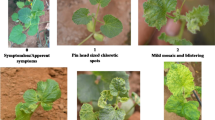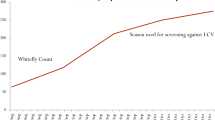Abstract
Mega variety with multiple disease and pest tolerance is one of the major research objectives to protect the crop from biotic stresses in current scenario of climate change. Three tomato leaf curl virus resistance genes (Ty-1, Ty-2 and Ty-3), two late blight resistance genes (Ph-2 and Ph-3) and one root knot nematodes resistance gene (Mi-1.2) were pyramided from different donor parents with the help of marker-assisted backcrossing followed by phenotypic selection. During 2016–2017 (August–March), 100 lines of BC1F4 mapping population were evaluated against these diseases and pest screening. Punjab Chhuhara (a popular north Indian tomato cultivar) was used as a recipient parent that is susceptible for all these diseases and pest. Whereas the resistant parents included CLN3022F2-154-11-11-0 for tomato leaf curl virus, LBR-15 for late blight and NR-5 for root knot nematodes. The study results evaluated, 13 advanced backcrossed lines which possessed multiple disease and pest resistance with better horticultural traits over the parents as well as checks. This investigation showed that the introgression of Ty-1, Ty-2, Ty-3, Ph-2, Ph-3 and Mi-1.2 genes significantly improved the resistance against leaf curl, late blight and root knot nematodes diseases in selected advanced backcrossed lines of tomato. These improved multiple diseases resistant lines may play an important role in future pre-breeding tomato improvement projects.







Similar content being viewed by others
References
Ammiraju JSS, Veremis JC, Huang X et al (2003) The heat-stable root-knot nematode resistance gene Mi-9 from Lycopersicon peruvianum is localized on the short arm of chromosome 6. Theor Appl Genet 106:478–484. https://doi.org/10.1007/s00122-002-1106-y
AOAC (2000) Official methods of analysis, 17th edn. The Association of Official Analytical Chemists, Gaithersburg
Banerjee MK, Kalloo MK (1987) Sources and inheritance of resistance to leaf curl virus in Lycopersicon. Theor Appl Genet 73:707–710. https://doi.org/10.1007/BF00260780
Boiteux LS, Charchar JM (1996) Genetic resistance to root-knot nematode (Meloidogyne javanica) in eggplant (Solanum melongena). Plant Breed 115:198–200. https://doi.org/10.1111/j.1439-0523.1996.tb00902.x
Bridge J, Page SLJ (1980) Estimation of root-knot nematode infestation levels on roots using a rating chart. Trop Pest Manag 26:296–298. https://doi.org/10.1080/09670878009414416
Cap GB, Roberts PA, Thomason IJ (1993) Inheritance of heat-stable resistance to Meloidogyne incognita in Lycopersicon peruvianum and its relationship to the Mi gene. Theor Appl Genet 85:777–783. https://doi.org/10.1007/BF00225019
Chen C-H, Sheu Z-M, Wang T-C (2008) Host specificity and tomato-related race composition of Phytophthora infestans isolates in Taiwan during 2004 and 2005. Plant Dis 92:751–755. https://doi.org/10.1094/PDIS-92-5-0751
Chunwongse J, Chunwongse C, Black L, Hanson P (2002) Molecular mapping of the Ph-3 gene for late blight resistance in tomato. J Hortic Sci Biotechnol 77:281–286. https://doi.org/10.1080/14620316.2002.11511493
Danso Y, Akromah R, Osei K (2011) Molecular marker screening of tomato (Solanum lycopersicum L.) germplasm for root-knot nematodes (Meloidogyne species) resistance. Afr J Biotechnol 10:1511–1515. https://doi.org/10.5897/ajb10.2095
De Barro PJ, Liu S-S, Boykin LM, Dinsdale AB (2011) Bemisia tabaci: a statement of species status. Annu Rev Entomol 56:1–19. https://doi.org/10.1146/annurev-ento-112408-085504
Dhaliwal MS, Sharma A (2016) Breeding for resistance to virus diseases in vegetable crops. In: Peter KV (ed) Innovations in horticultural sciences. New India Publishing Agency, New Delhi, pp 303–327
Dhaliwal MS, Jindal SK, Sharma A et al (2018) Breeding tomato for leaf curl virus resistance. Agric Res J 55:38. https://doi.org/10.5958/2395-146X.2018.00006.6
Doyle JJ, Doyle JL (1987) A rapid DNA isolation procedure for small quantities of fresh leaf tissue. Phytochem Bull 19:15–87. https://doi.org/10.2307/4119796
Elling AA (2013) Major emerging problems with minor Meloidogyne species. Phytopathology 103:1092–1102. https://doi.org/10.1111/j.1570-7458.1994.tb01789.x
Foolad MR, Merk HL, Ashrafi H, Kinkade MP (2006) Identification of new sources of late blight resistance in tomato and mapping of a new resistance gene. In: Ivors K (ed) Proceeding of the 21st annual tomato disease workshop, North Carolina State University, Fletcher, NC, USA, 9–10 Nov 2006
Foolad MR, Merk HL, Ashrafi H (2008) Genetics, genomics and breeding of late blight and early blight resistance in tomato. CRC Crit Rev Plant Sci 27:75–107. https://doi.org/10.1080/07352680802147353
Gallegly ME, Marvel ME (1955) Inheritance of resistance to tomato race O of Phytophthora infestans. Phytopathology 45:103–109. https://doi.org/10.1063/1.1627472
Garcia BE, Maxwell DP (2007) Analysis of sequences from the TG105 marker of chromosome 11 as a tag for Ty-2 locus from S. habrochaites. 144.92.198.11/GeminivirusResistantTomatoes/Markers/TG105.pdf
Gardner RG, Panthee DR (2010) NC 1 CELBR and NC 2 CELBR: early blight and late blight-resistant fresh market tomato breeding lines. HortScience 45:975–976
Hadisoeganda W, Sasser JN (1982) Resistance of tomato, bean, southern pea, and garden pea cultivars to root-knot nematodes based on host suitabilty. Plant Dis 66:145–150. https://doi.org/10.1094/PD-66-145
Hutton SF, Scott JW (2014) Ty-6, a major begomovirus resistance gene located on chromosome 10. Rep Tomato Genet Coop 64:14–18
Hutton SF, Scott JW, Schuster DJ (2012) Recessive resistance to tomato yellow leaf curl virus from the tomato cultivar Tyking is located in the same region as ty-5 on chromosome 4. HortScience 47:324–327
Jacquet M, Bongiovanni M, Martinez M et al (2005) Variation in resistance to the root-knot nematode Meloidogyne incognita in tomato genotypes bearing the Mi gene. Plant Pathol 54:93–99. https://doi.org/10.1111/j.1365-3059.2005.01143.x
Ji Y, Salus MS, Van Betteray B et al (2007) Co-dominant SCAR markers for detection of the Ty-3 and Ty-3a loci from Solanum chilense at 25 cM of chromosome 6 of tomato. Life Sci 57:6–9
Kalloo G, Banerjee M (2000) H:24 moderately leaf curl resistant variety of tomato (Lycopersicon esculentum Mill.). Veg Sci 27:117–120
Kanakala S, Jyothsna P, Shukla R et al (2013) Asymmetric synergism and heteroencapsidation between two bipartite begomoviruses, tomato leaf curl New Delhi virus and tomato leaf curl Palampur virus. Virus Res 174:126–136. https://doi.org/10.1016/j.virusres.2013.03.011
Kaur S (2014) Screening of tomato (Solanum lycopersicum L.) germplasm for root-knot nematode resistance using conventional and molecular marker techniques. Indian J Nematol 44:56–61
Luthria DL, Mukhopadhyay S, Krizek DT (2006) Content of total phenolics and phenolic acids in tomato (Lycopersicon esculentum Mill.) fruits as influenced by cultivar and solar UV radiation. J Food Comp Anal 19:771–777. https://doi.org/10.1016/j.jfca.2006.04.005
McKinney H (1923) Influence of soil temperature and moisture on infection of wheat seedlings by Helminthosporium sativum. J Agric Res 26:195–218
Merk HL, Ashrafi H, Foolad MR (2012) Selective genotyping to identify late blight resistance genes in an accession of the tomato wild species Solanum pimpinellifolium. Euphytica 187:63–75. https://doi.org/10.1007/s10681-012-0729-6
Milligan S, Bodeau J, Yaghoobi J et al (1998) The root knot nematode resistance gene Mi from tomato is a member of the leucine zipper, nucleotide binding, leucine-rich repeat family of plant genes. Plant Cell 10:1307–1319. https://doi.org/10.1105/tpc.10.8.1307
Mutschler-Chu M (2018) https://plbrgen.cals.cornell.edu/people/martha-mutschler-chu/
Nelson SC (2008) Late blight of tomato (Phytophthora infestans). Coop Ext Serv 45:1–10
Panthee DR, Gardner RG (2011) ‘Mountain Merit’: a late tomato hybrid. HortScience 45:1547–1548
Peng D, Tang W (2001) Advance of resistance gene Mi to root-knot nematodes in tomato. Yournal Shenyang Agric Univ 32:220
Pérez De Castro A, Blanca JM, Díez MJ, Nuez Viñals F (2007) Identification of a CAPS marker tightly linked to the tomato yellow leaf curl disease resistance gene Ty-1 in tomato. Eur J Plant Pathol 117:347–356. https://doi.org/10.1007/s10658-007-9103-2
Prasanna HC, Sinha DP, Rai GK et al (2015) Pyramiding Ty-2 and Ty-3 genes for resistance to monopartite and bipartite tomato leaf curl viruses of India. Plant Pathol 64:256–264. https://doi.org/10.1111/ppa.12267
Seah S, Williamson VM, Garcia BE et al (2007) Evaluation of a co-dominant SCAR marker for detection of the Mi-1 locus for resistance to root-knot nematode in tomato germplasm. Tomato Genet Coop Rep 57:37–40
Shankarappa KS, Sriharsha Rangaswamy KT et al (2008) Development of tomato hybrids resistant to tomato leaf curl virus disease in South India. Euphytica 164:531–539. https://doi.org/10.1007/s10681-008-9750-1
Srivastava RP, Kumar S (2002) Fruit and vegetable preservation: principles and practices. International Book Distribution Co., Lucknow, pp 353–364
Taylor AL, Sasser JN (1978) Biology, identification and control of root-knot nematodes (Meloidogyne species). Department of Plant Pathology, North Carolina State University, United States Agency for International Development, Raleigh
Tiwari N, Padmalatha KV, Singh VB et al (2010) Tomato leaf curl Bangalore virus (ToLCBV): infectivity and enhanced pathogenicity with diverse betasatellites. Arch Virol 155:1343–1347. https://doi.org/10.1007/s00705-010-0710-4
Veremis JC, Van Heusden AW, Roberts PA (1999) Mapping a novel heat-stable resistance to Meloidogyne in Lycopersicon peruvianum. Theor Appl Genet 98:274–280. https://doi.org/10.1007/s001220051068
Wang Q, Ge C, Yin G et al (2001) Progress on breeding for resistance to root-knot nematodes in tomato. J Laiyang Agric Coll 18:216–220
Williamson VM, Hussey RS (1996) Nematode pathogenesis and resistance in plants. Plant Cell 8:1735. https://doi.org/10.2307/3870226
Zhou E, Wheeler T, Starr J (2000) Root galling and reproduction of Meloidogyne incognita isolates from texas on resistant cotton genotypes. J Nematol 32:513–518
Acknowledgements
Funding for gene pyramiding was granted by the Department of Biotechnology (BT/PR6499/AGII/106/890/2012), Government of India. The authors are also thankful to Dr. Peter Hanson, World Vegetable Centre, Taiwan for providing resistant sources of late blight and leaf curl virus.
Author information
Authors and Affiliations
Contributions
Conceptualization of research work and designing of experiments (AK, SKJ); Execution of field/lab experiments and data collection (AK, SKJ, AS, SK, SJ); Analysis of data and interpretation (AK, MSD); Preparation of manuscript (AK, SKJ, AS).
Corresponding author
Ethics declarations
Conflict of interest
The authors declare that they have no conflict of interests.
Human and animal rights
This research did not contain any studies on human and/or animal participants performed by any of the authors.
Additional information
Publisher's Note
Springer Nature remains neutral with regard to jurisdictional claims in published maps and institutional affiliations.
Electronic supplementary material
Below is the link to the electronic supplementary material.
Rights and permissions
About this article
Cite this article
Kumar, A., Jindal, S.K., Dhaliwal, M.S. et al. Gene pyramiding for elite tomato genotypes against ToLCV (Begomovirus spp.), late blight (Phytophthora infestans) and RKN (Meloidogyne spp.) for northern India farmers. Physiol Mol Biol Plants 25, 1197–1209 (2019). https://doi.org/10.1007/s12298-019-00700-5
Received:
Revised:
Accepted:
Published:
Issue Date:
DOI: https://doi.org/10.1007/s12298-019-00700-5




